Don’t have time to read Dobbs? Here’s our notes.
If you don’t want to read the 213 page opinion yourself, here are some brief notes I took.
First and foremost: “Held: The Constitution does not confer a right to abortion; Roe and Casey are overruled; and the authority to regulate abortion is returned to the people and their elected representatives.”

The Court argues that Casey skipped the question of whether the Constitution confers a right to abortion and reaffirmed Roe based on precedent alone. So the Court will consider that question now, with Dobbs. Specifically the Court will consider whether (1) there’s an implicit Constitutional right to abortion in the 14th Amendment, (2) abortion is rooted in our nation’s history and tradition, and (3) a right to abortion is part of a broader entrenched right supported by precedents.
Is a right to abortion rooted in our nation’s history and tradition? No. No, it is not. “By the time the Fourteenth Amendment was adopted, three fourths of the States had made abortion a crime at any stage of pregnancy. This consensus endured until the day Roe was decided.” So historically we not only didn’t recognize abortion as a right, we did recognize it as a crime. By the way, keep this in mind when pro-choicers claim no one really cared about abortion until Republicans made it a wedge issue with Evangelicals post-Roe (or some other version of that revisionist history).
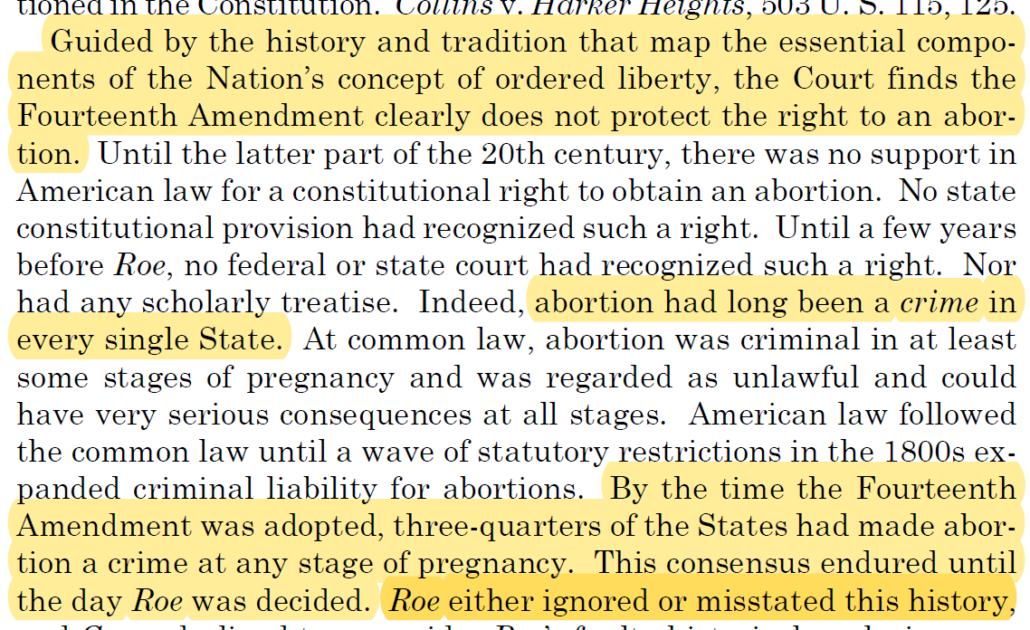
In Dobbs the Court managed to do what so many abortion activists will not: acknowledge that abortion involves the “critical moral question” of the morality and legality of destroying humans in utero: “What sharply distinguishes the abortion right from the rights recognized in the cases on which Roe and Casey rely is something that both those decisions acknowledged: Abortion is different because it destroys what Roe termed ‘potential life’ and what the law challenged in this case calls an “unborn human being.” None of the other decisions cited by Roe and Casey involved the critical moral question posed by abortion.”

In addressing the argument that Roe is precedent (stare decisis), the Court says “stare decisis is not an inexorable command,” especially when SCOTUS interprets the Constitution. They point to Brown v. Board of Education overturning Plessy v. Ferguson as an example. The Court lists five factors when deciding whether to overrule precedent:
- The nature of the Court’s error
- The quality of the reasoning
- Workability
- Effect on other areas of law
- Reliance interests
On “The nature of the Court’s error”: “Roe was also egregiously wrong and on a collision course with the Constitution from the day it was decided.”
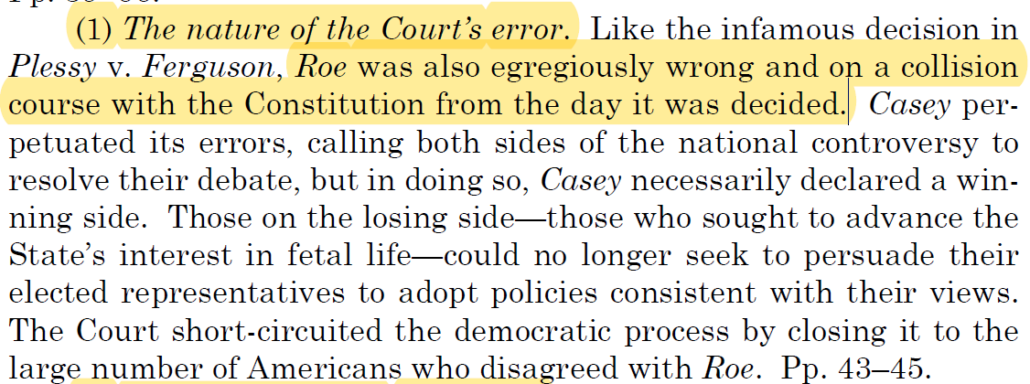
On “the quality of the reasoning”: Roe was basically legislating from the bench, imposing “on the entire country a detailed set of rules for pregnancy…that one might expect to find in a statute or regulation” and with no grounding in constitutional text, history, or precedent. “Roe’s failure even to note the overwhelming consensus of state laws in effect in 1868 is striking, and what it said about the common law was simply wrong.”

The Court slams Roe for its nonsensical viability standard. “An even more glaring deficiency was Roe‘s failure to justify the critical distinction it drew between pre- and post-viability abortions. … The most obvious problem is that viability…is heavily dependent on factors-such as medical advances and the availability of quality medical care-that have nothing to do with the characteristics of the fetus.”

And the Court was extremely unimpressed with Casey v Planned Parenthood. “Casey, in short, either refused to reaffirm or rejected important aspects of Roe‘s analysis, failed to remedy glaring deficiencies in Roe‘s reasoning, endorsed what it termed Roe‘s central holding while suggesting that a majority might not have thought it was correct, provided no new support for the abortion right other than Roe‘s status as precedent, and imposed a new test with no firm grounding in constitutional text, history, or precedent.”
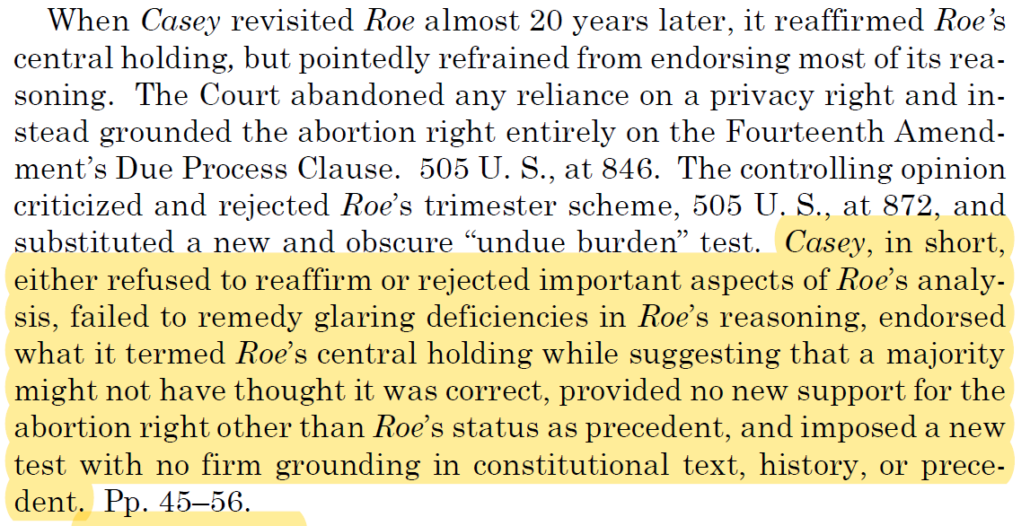
On “Workability”: Basically the Court says Casey‘s “undue burden” test has proven very unworkable. “Casey has generated a long list of Circuit conflicts.”
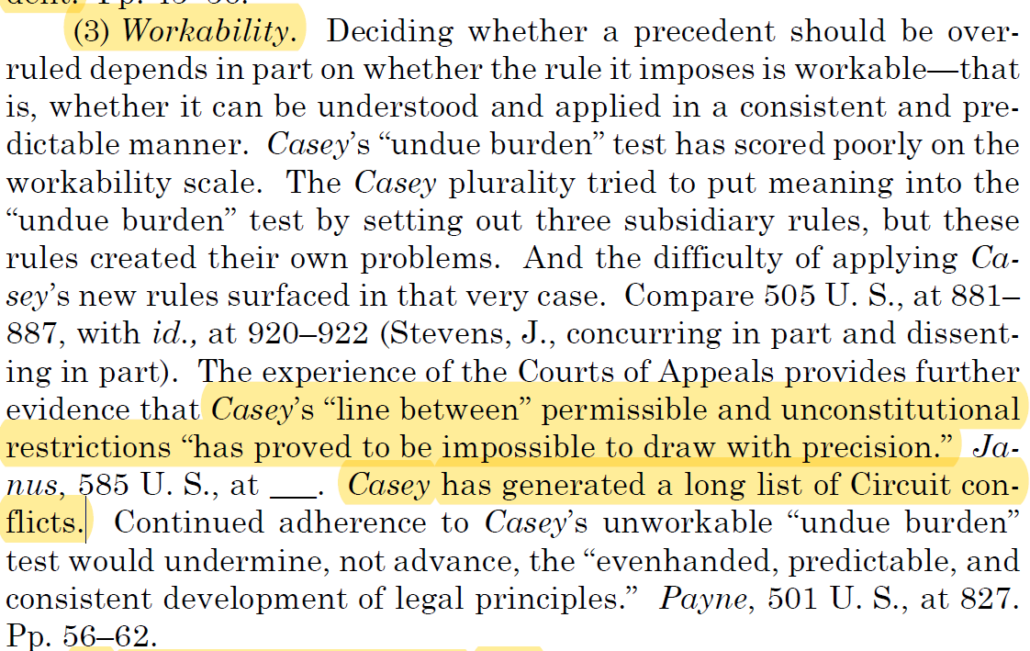
On Effect on other areas of law: they are vaguer. I’ll have to see if they get detailed once I get to the majority opinion.

On Reliance Interests: Court says Casey conceded that “traditional” reliance interests aren’t at play here but tried to come up with a “more intangible” form of reliance that was akin to substituting “their social and economic beliefs for the judgment of legislative bodies.” Longer quote: “Instead, the opinion perceived a more intangible form of reliance, namely, that ‘people [had] organized intimate relationships and made choices that define their views of themselves and their places in society … in reliance on the availability of abortion in the event that contraception should fail’ and that ‘[t]he ability of women to participate equally in the economic and social life of the Nation has been facilitated by their ability to control their reproductive lives.’ Ibid. The contending sides in this case make impassioned and conflicting arguments about the effects of the abortion right on the lives of women as well as the status of the fetus.”
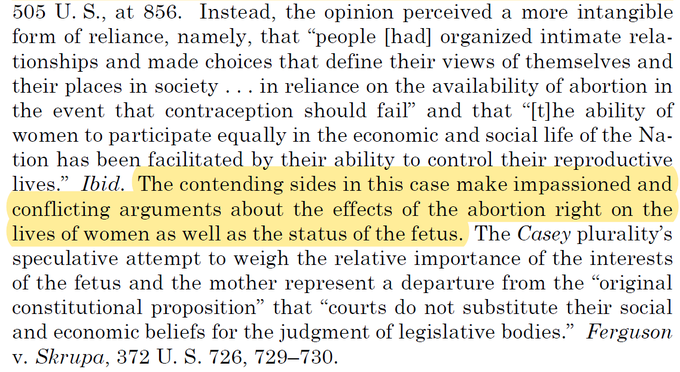
We’ll see a lot of debate about whether Dobbs threatens contraception, gay marriage, or other issues that are vastly more accepted by the public than abortion is. Expect to see this quote often. “The Court emphasizes that this decision concerns the constitutional right to abortion and no other right. Nothing in this opinion should be understood to cast doubt on precedents that do not concern abortion.”

Casey worried that if SCOTUS overturned Roe, people would think it was due to public opinion or political considerations. But this Court considers worry about its reputation to be an “extraneous concern” compared to its job of correctly interpreting the law: “The Court’s job is to interpret the law, apply longstanding principles of stare decisis, and decide this case accordingly.”
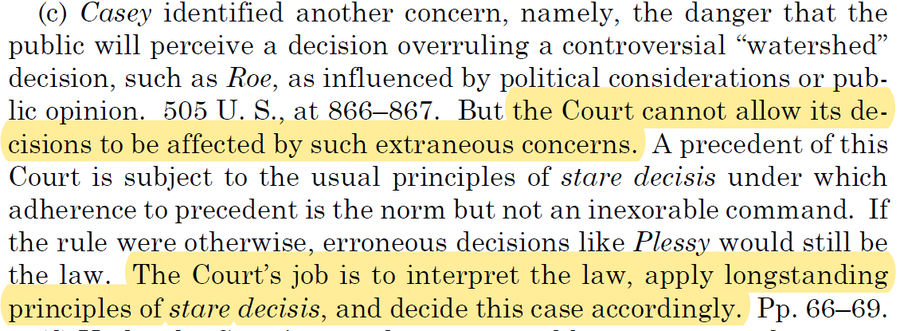
Done with the syllabus, onto the majority opinion. It was 6-3 Alito, Thomas, Gorsuch, Kavanaugh, Barrett, and Roberts vs Breyer, Sotomayor, and Kagan.

Alito pulls no punches, talking about how Roe rested on information that was “constitutionally irrelevant” or even “plainly incorrect.” Longer quote: “For the first 185 years after the adoption of the Constitution, each State was permitted to address this issue in accordance with the views of its citizens. Then, in 1973, this Court decided Roe v. Wade. Even though the Constitution makes no mention of abortion, the Court held that it confers a broad right to obtain one. It did not claim that American law or the common law had ever recognized such a right, and its survey of history ranged from the constitutionally irrelevant (e.g. its discussion of abortion in antiquity) to the plainly incorrect (e.g. its assertion that abortion was probably never a crime under the common law). After cataloging a wealth of other information having no bearing on the meaning of the Constitution, the opinion concluded with a numbered set of rules much like those that might be found in a statute enacted by a legislature.”
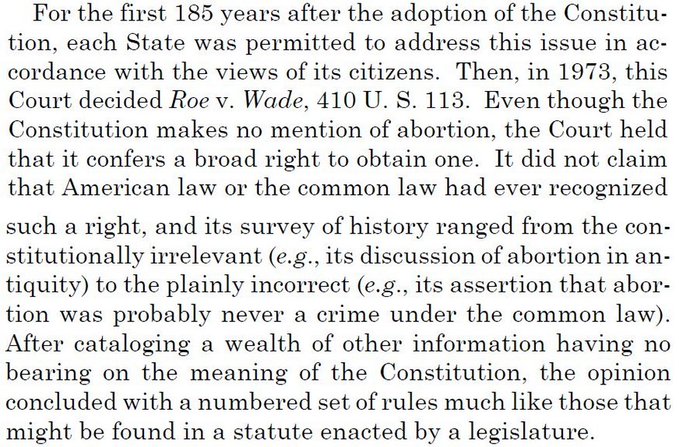
“At the time of Roe, 30 States still prohibited abortion at all stages. In the years prior to that decision, about a third of the States had liberalized their laws, but Roe abruptly ended that political process. It imposed the same highly restrictive regime on the entire Nation, and it effectively struck down the abortion laws of every single State.” I believe in this context, “liberalized” laws were still more restrictive than what Roe required of everyone.

So in Casey, in terms of whether Roe was correctly reasoned, it was 4 (no) to 3 (decline to state, hint at no) to 2 (yes). “Two Justices expressed no desire to change Roe in any way. Four others wanted to overrule the decision in its entirety. And the three remaining Justices, who jointly signed the controlling opinion, took a third position. Their opinion did not endorse Roe‘s reasoning, and it even hinted that one or more of its authors might have “reservations” about whether the Constitution protects a right to abortion. But the opinion concluded that stare decisis, which calls for prior decisions to be followed in most instances, required adherence to what it called Roe’s ‘central holding.'”
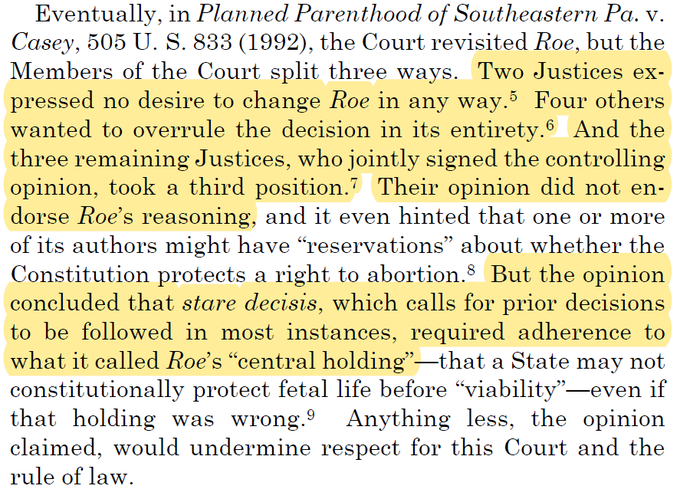
In Casey’s controlling opinion they “called the contending sides of a national controversy to end their national division.” This was in 1992. Guess you could say their call didn’t work.

Alito again distinguishes between abortion and other rights defended under the 14A. There are a whole lot of people who oppose abortion who don’t take the same issue with gay marriage, contraception, or other sex-adjacent topics. Why? Because abortion kills humans. “The abortion right is also critically different from any other right that this Court has held to fall within the Fourteenth Amendment’s protection of ‘liberty.’ Roe‘s defenders characterize the abortion right as similar to the rights recognized in past decisions involving matters such as intimate sexual relations, contraception, and marriage, but abortion is fundamentally different, as both Roe and Casey acknowledged, because it destroys what those decisions called ‘fetal life’ and what the law now before us describes as an ‘unborn human being.'”
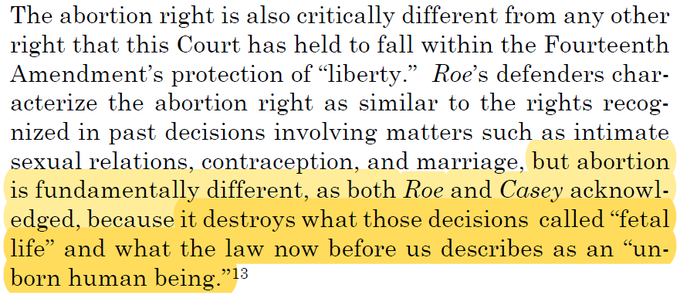
Legalese way to say this isn’t about hating/controlling women. “As the Court has stated, the ‘goal of preventing abortion’ does not constitute ‘invidiously discriminatory animus’ against women.” The Court roundly rejects the idea that the Equal Protection Clause is at play here.

To determine whether a right is incorporated in the Due Process clause, the Court considers whether that right is “deeply rooted in [our] history and tradition” and is essential to our Nation’s “scheme of ordered liberty.”
The right to an abortion isn’t deeply rooted in our history: “Not only was there no support for such a constitutional right until shortly before Roe, but abortion had long been a crime in every single State.” “Roe either ignored or misstated this history.”
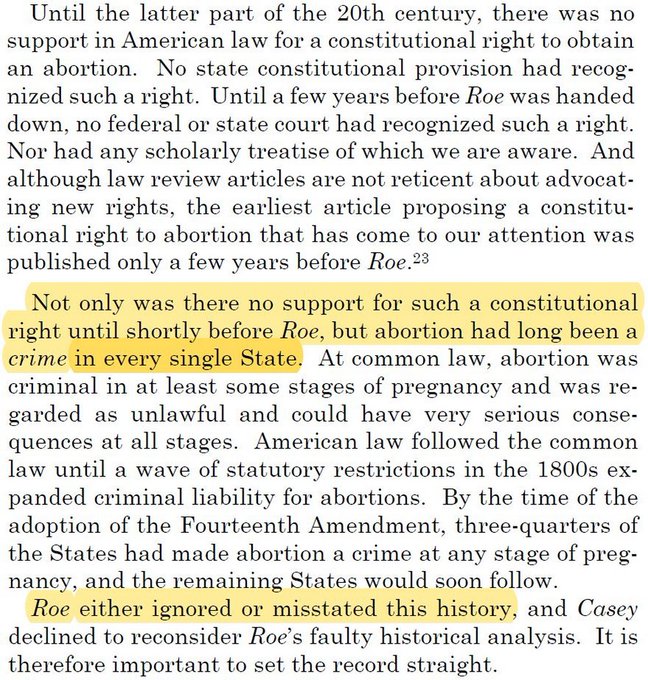
The opinion goes on from pages 19-26 to review the historical record and notes many examples of how abortion was treated as a crime, and certainly not as a right, prior to Roe. “It is revealing that Hale and Blackstone treated abortionists differently from other physicians or surgeons who caused the death of a patient ‘without any intent of doing [the patient] any bodily hurt.'” “The few cases available from the early colonial period corroborate that abortion was a crime.”
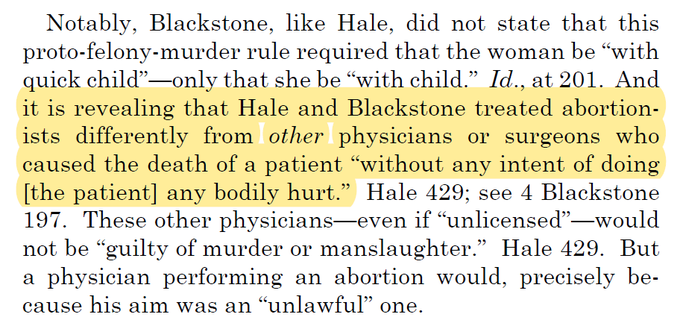
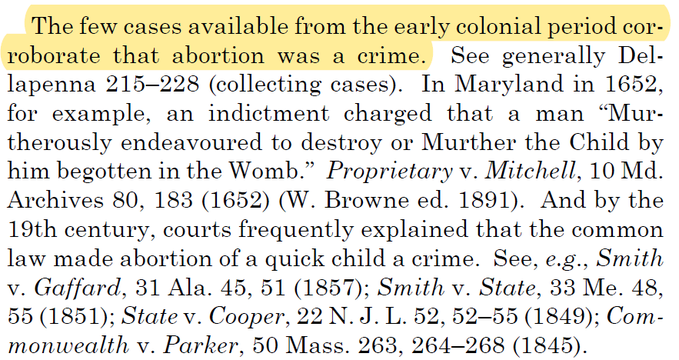
Importantly, early 1800s laws regulated abortion only after quickening because they lacked the scientific methods to detect earlier pregnancy. As scientific knowledge improved, abortion was restricted earlier in pregnancy. Pro-science, pro-life. “At that time, there were no scientific methods for detecting pregnancy in its early stages.” “(‘In contemplation of law life commences at the moment of quickening, at that moment when the embryo gives the first physical proof of life‘”
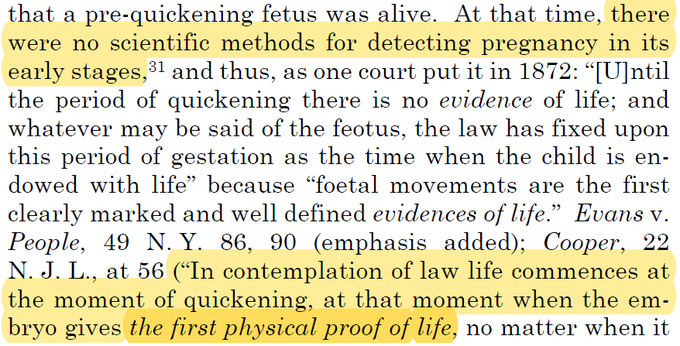
So the Court is supposed to look to our nation’s tradition and history when determining a right incorporated in the Due Process Clause. And traditionally, we criminalized abortion from the beginning until Roe itself. Huge fail on Roe’s part. “The inescapable conclusion is that a right to abortion is not deeply rooted in the Nation’s history and traditions. On the contrary, the unbroken tradition of prohibiting abortion on pain of criminal punishment persisted from the earliest days of the common law until 1973.”

Alito is deeply unimpressed with the pro-choice side’s inability to argue that our country had any history of a right to an abortion. “Not only are respondents and their amici unable to show that a constitutional right to abortion was established when the Fourteenth Amendment was adopted, but they have found no support for the existence of an abortion right that predates the latter part of the 20th century–no state constitutional provision, no statute, no judicial decision, no learned treatise.”
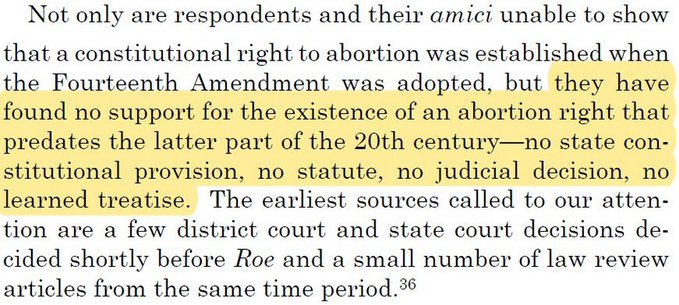
It’s hard to pick a favorite passage, but this is way up there. Just like your beliefs about the “mystery of life” don’t leave you free to kill infants, they don’t give you an unquestioned right to abortion. “While individuals are certainly free to think and to say what they wish about ‘existence,’ ‘meaning,’ the ‘universe,’ and ‘the mystery of human life,’ they are not always free to act in accordance with those thoughts.”

Alito again emphasizes that the pro-choice side has zero historical ground to stand on. “The dissent’s failure to engage with this long tradition is devastating to its position.”
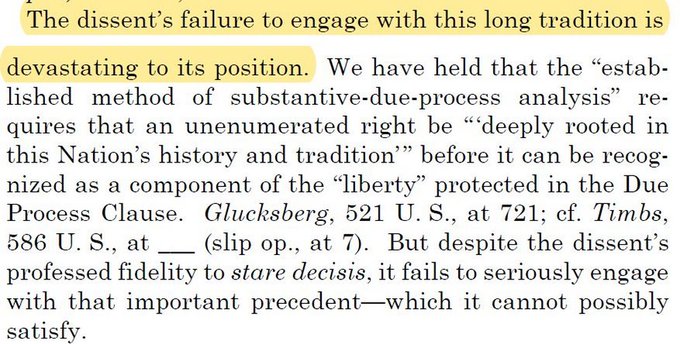
“The most striking feature of the dissent is the absence of any serious discussion of the legitimacy of the States’ interest in protecting fetal life.” Maybe striking to SCOTUS, but not to those of us debating this regularly. Pro-choicers do not like acknowledging the humans who are killed by abortion.

The Court again emphasizes that precedent is important but not inescapable. Below are screencaps of the footnote listing a partial list of times the Court has overruled prior constitutional decisions.
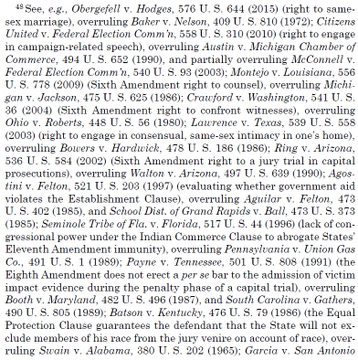
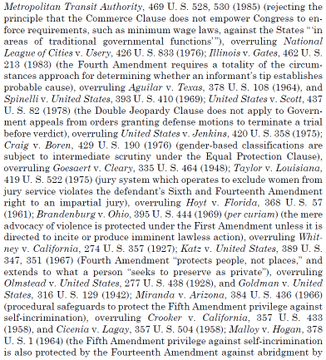
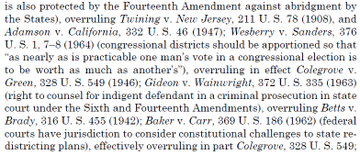
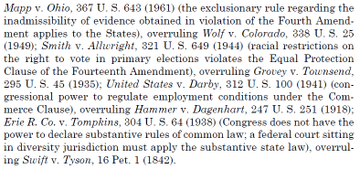
Court says that Roe wasn’t just incorrect, it was really REALLY incorrect. Weak reasoning all around, just come on, seriously. “We explained why Roe was incorrectly decided, but that decision was more than just wrong. It stood on exceptionally weak ground.”
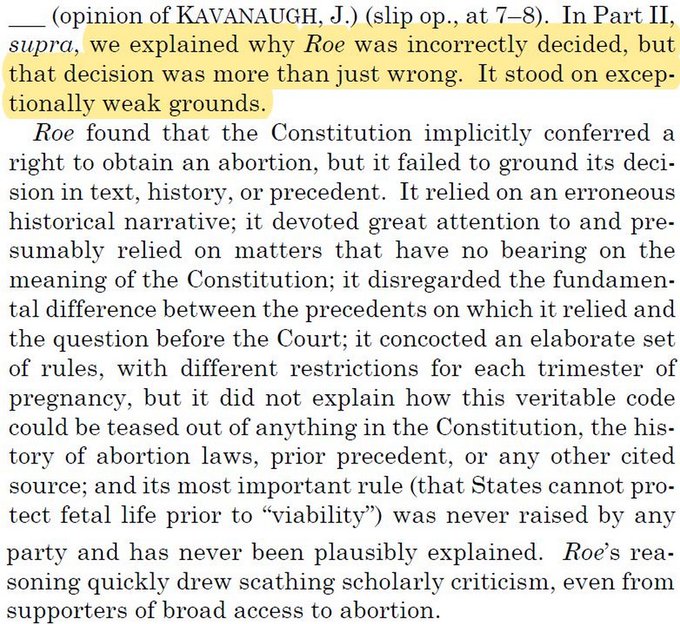
Alito chides Roe for conflating two different meanings of “personal privacy”: (1) the right to shield info from disclosure vs (2) right to make important personal decisions without gov’t interference. Only the second meaning is relevant to the abortion debate. And even within the second meaning, Roe cites cases related to marriage and procreation (e.g. contraception), but none of these precedents involved the question of state interest in fetal life.
Roe‘s viability standard makes no sense at all. Why would state interest in fetal life be compelling after viability but not before? Roe doesn’t even try to say. “If, as Roe held, a State’s interest in protecting prenatal life is compelling ‘after viability,’ why isn’t that interest ‘equally compelling before viability’?” “Roe did not say.”
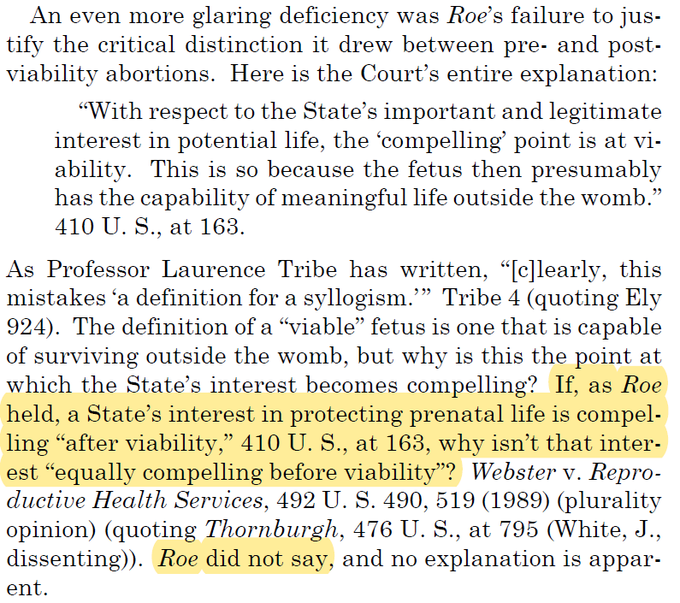
And now Alito addresses (some) personhood arguments, and rightly recognizes that they undermine the humanity of not only fetuses but also groups of born people. Also, most of them have nothing to do with viability. It’s all so ad hoc, isn’t it? “Among the characteristics that have been offered as essential attributes of ‘personhood’ are sentience, self-awareness, the ability to reason, or some combination thereof. By this logic, it would be an open question whether even born individuals, including young children or those afflicted with certain developmental or medical conditions, merit protections as ‘persons.’ But even if one takes the view that ‘personhood’ begins with a certain attribute or combination of attributes is acquired, it is very hard to see why viability should mark the point where ‘personhood’ begins.

Alito really hates the viability standard. “So, according to Roe‘s logic, States now have a compelling interest in protecting a fetus with a gestational age of, say, 26 weeks, but in 1973 States did not have an interest in protecting an identical fetus. How can that be?” “Thus, a 24-week-old fetus may be viable if a woman gives birth in a city with hospitals that provide advanced care for very premature babies, but if the woman travels to a remote area far from any such hospital, the fetus may no longer be viable. On what ground could the constitutional status of a fetus depend on the pregnant woman’s location?”
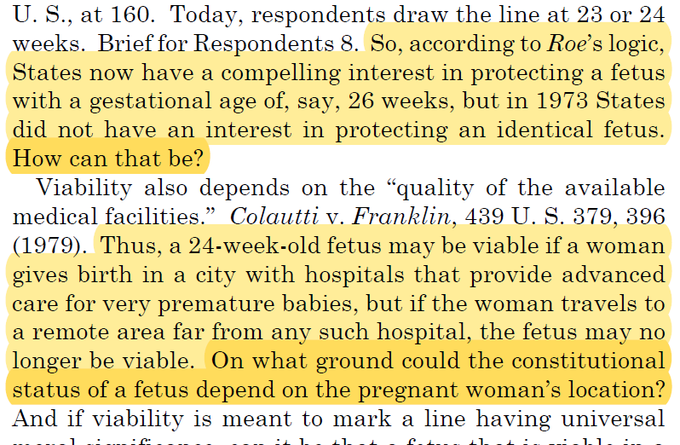
“Is a fetus viable with a 10 percent chance of survival? 25 percent? 50 percent? Can such a judgment be made by a State?”
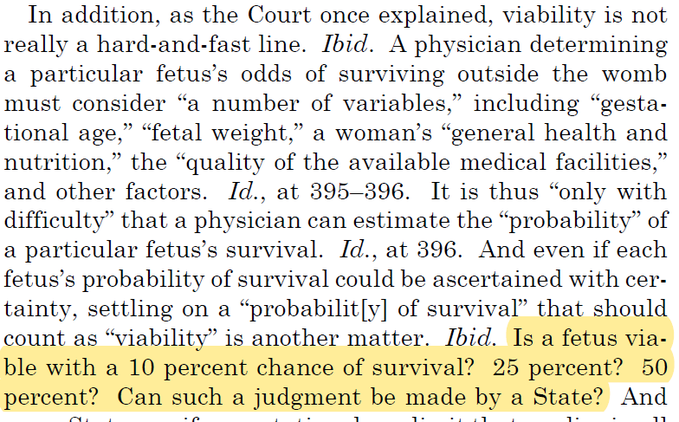
This is why polls talking about public support for Roe were a waste of time. Most of the public had no idea what Roe did. I am so, so glad it’s gone. “Despite Roe’s weaknesses, its reach was steadily extended in the years that followed. The Court struck down laws requiring that second-trimester abortions be performed only in hospitals, that minors obtain parental consent, that women give written consent after being informed of the status of the developing prenatal life and the risks of abortion, that women wait 24 hours for an abortion, that a physician determines viability in particular manner, that a physician performing a post-viability abortion use the technique most likely to preserve the life of the fetus, and that fetal remains be treated in a humane and sanitary manner.”
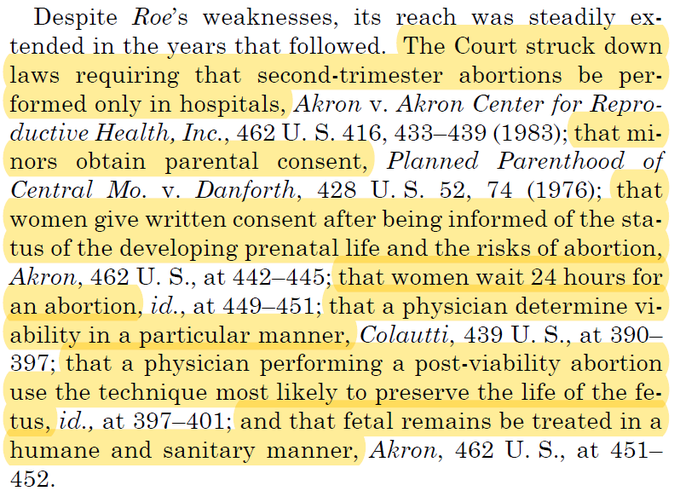
Pages 57-62 of Dobbs opinion outline how unworkable Casey’s “undue burden” test was, suggesting it was really no better than Roe’s trimester framework before it.
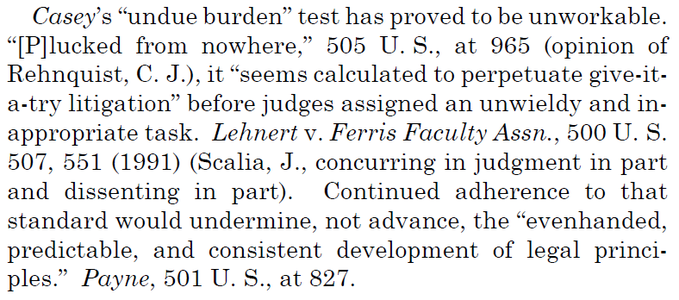
Abortion corrupts. “The Court’s abortion cases have diluted the strict standard for facial constitutional challenges. They have ignored the Court’s third-party standing doctrine. They have disregarded standard res judicata principles. They have flouted the ordinary rules on the severability of unconstitutional provisions, as well as the rule that statutes should be read where possible to avoid unconstitutionality. And they have distorted First Amendment doctrines.
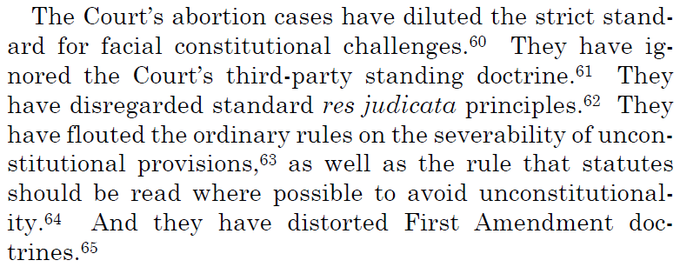
Abortion advocates argue that women over the decades have ordered our lives around the availability of abortion, & that we rely on abortion access to participate meaningfully in society. (Secular Pro-Life cosigned an amicus brief strongly disagreeing.) But the Court notes that in Casey v Planned Parenthood they readily agreed that traditional reliance interests are not involved in issues of abortion. “Reproductive planning could take virtually immediate account of any sudden restoration of state authority to ban abortions.”
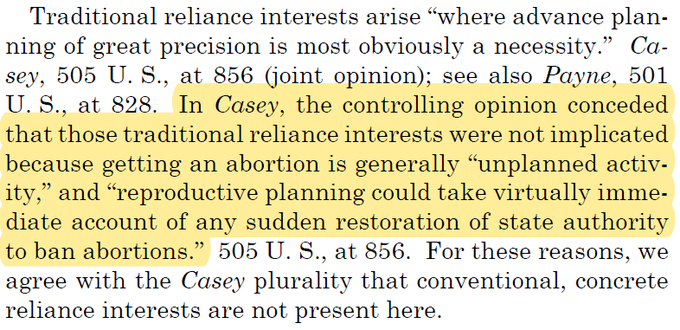
Research confirms this idea. For example, numerous studies have found that when abortion is restricted, more people use contraception. See this thread for links to such studies.
And last but definitely not least, it turns out the Supreme Court of the United States of America, in their decision to overturn the abomination that was Roe v. Wade, cited our amicus brief. What an honor! “The contending sides in this case make impassioned and conflicting arguments about the effects of the abortion right on the lives of women. Compare Brief for Petitioners 34-36; Brief for Women Scholars et al. as Amici Curiae 13-20″ Amazing!

PS – I like how Alito seems to refuse to endorse the idea of “potential life.” He repeatedly puts the phrase (from Roe) in quotes and says “what they termed” or “what those decisions call” “potential life.” The embryo and fetus aren’t potential life. They are already alive.
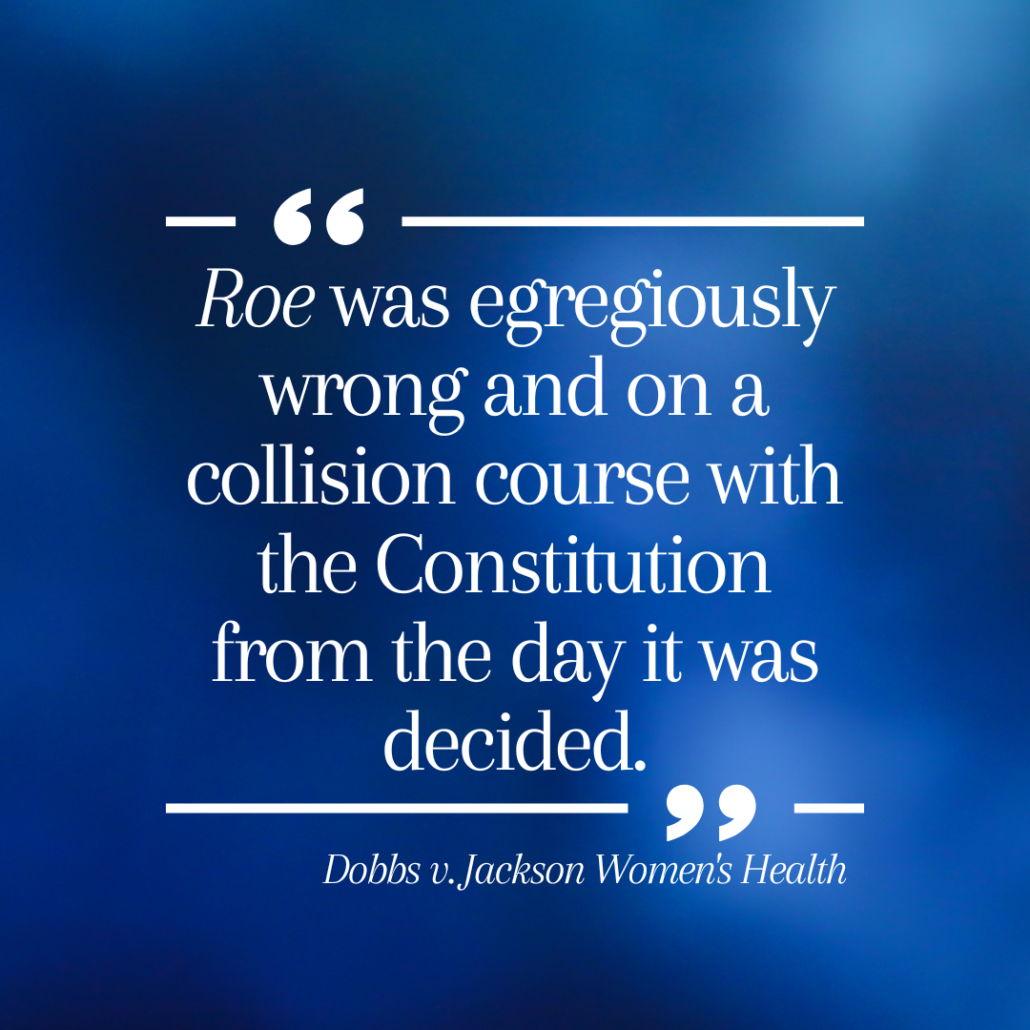

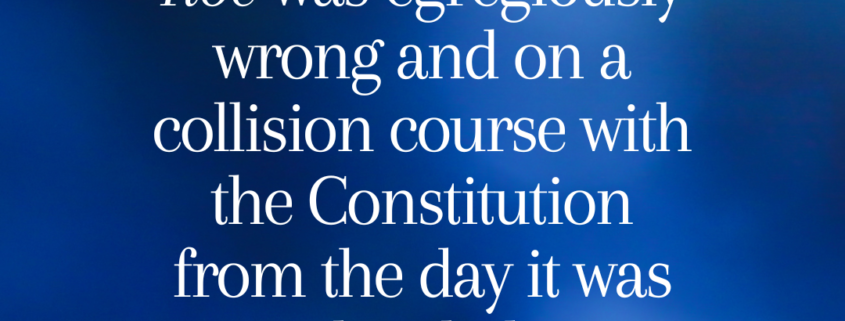


Good work.
“In Dobbs the Court managed to . . . acknowledge that abortion involves the ‘critical moral question’ of the morality and legality of destroying humans in utero: ‘What sharply distinguishes the abortion right from the rights recognized in the cases on which Roe and Casey rely is something that both those decisions acknowledged: Abortion is different because it destroys what Roe termed “potential life” and what the law challenged in this case calls an “unborn human being.” None of the other decisions cited by Roe and Casey involved the critical moral question posed by abortion.'”
Doesn’t Dobbs go beyond just stating that there is a question? I think it answers the question at least to a small extent. “Abortion is different because” is the thinking of the Dobbs majority, not of the opinions it refers to. This means that the Dobbs majority definitely (not just a question) felt that abortion is different from other issues, and based the assertion that it’s different (and hence partially based its ruling) on the destruction of the unborn. This implicitly means that the unborn definitely DOES have value – at least enough value to unequivocally declare abortion jurisprudentially different from other issues.